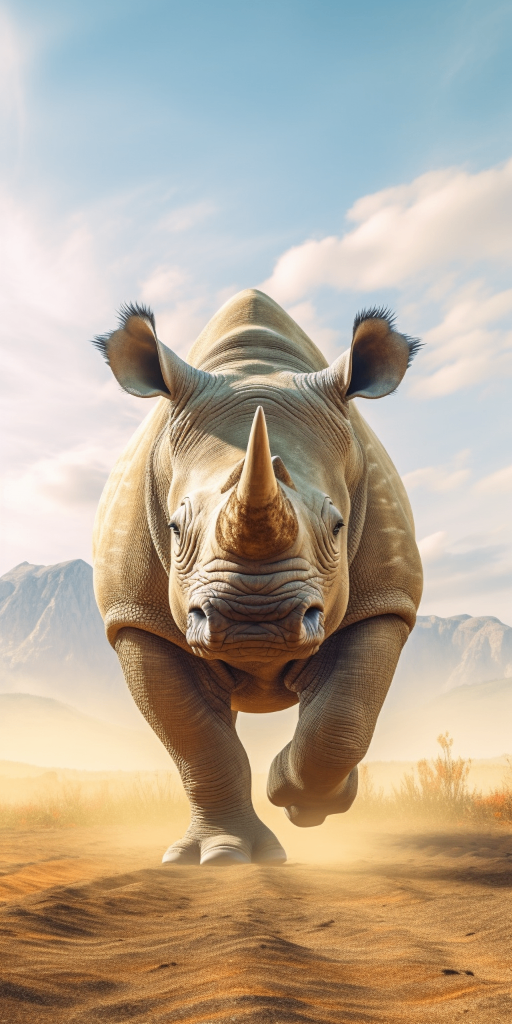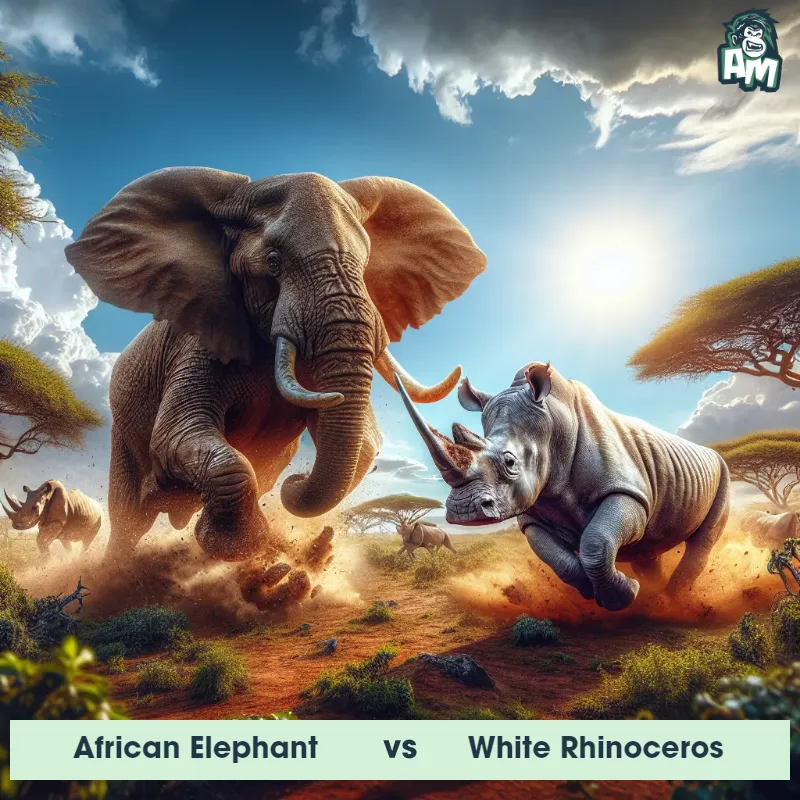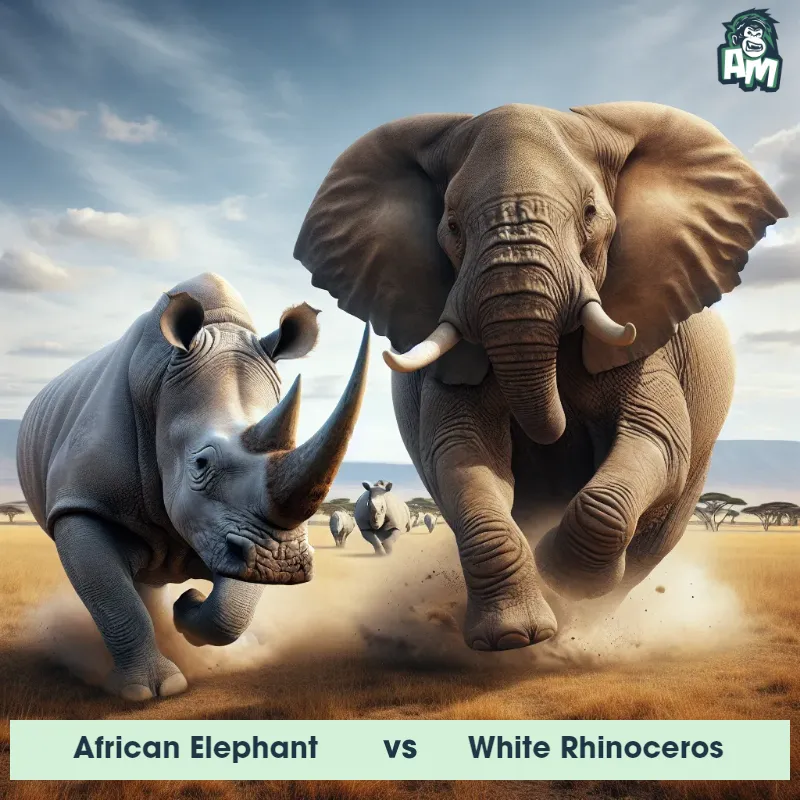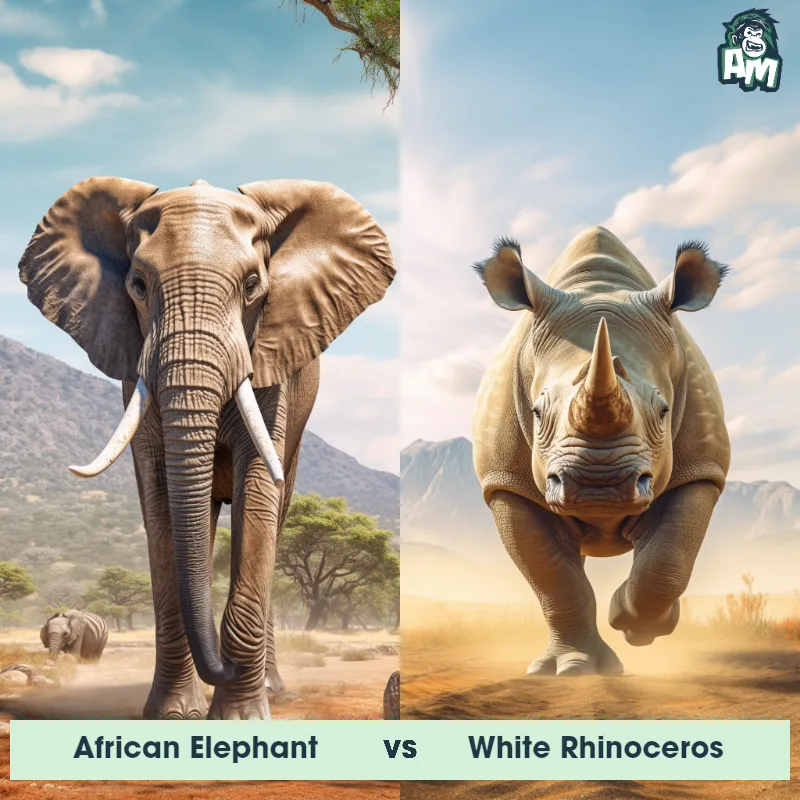The White Rhinoceros
The White Rhinoceros, also known as the Square-lipped Rhinoceros, is one of the largest land mammals, weighing up to 2.5 tons and measuring up to 6 feet tall at the shoulder. It is characterized by its massive size, distinctive horn on the front of its face, and greyish-brown skin with wrinkled folds. Despite their name, they are actually gray in color rather than white. They have a square-shaped upper lip, specifically adapted for grazing on grasses, their primary food source. White Rhinos are social animals and live in small groups called crashes, consisting of females and their offspring. They have poor eyesight but possess an acute sense of smell and hearing.

| White Rhinoceros | |
|---|---|
| Size | Up to 6 feet (1.8 meters) tall at the shoulder |
| Weight | Up to 5,000 pounds (2,300 kg) |
| Speed | Speed: 30 mph (48 km/hr) |
| Key Strength | Powerful charge with their massive body |
| Biggest Weakness | Poor eyesight and slow movement |
| Scientific Name | Ceratotherium simum |
| Family | Rhinocerotidae |
| Habitat | Grasslands and savannas |
| Geography | Southern and Eastern Africa |
| Diet | Herbivorous, primarily grazing on grass |
| Lifespan | 40 years - 50 years |

The White Rhinoceros
The White Rhinoceros, also known as the Square-lipped Rhinoceros, is one of the largest land mammals, weighing up to 2.5 tons and measuring up to 6 feet tall at the shoulder. It is characterized by its massive size, distinctive horn on the front of its face, and greyish-brown skin with wrinkled folds. Despite their name, they are actually gray in color rather than white. They have a square-shaped upper lip, specifically adapted for grazing on grasses, their primary food source. White Rhinos are social animals and live in small groups called crashes, consisting of females and their offspring. They have poor eyesight but possess an acute sense of smell and hearing.
Fun Fact: The White Rhinoceros is the second largest land mammal, after the African Elephant.
| White Rhinoceros | |
|---|---|
| Size | Up to 6 feet (1.8 meters) tall at the shoulder |
| Weight | Up to 5,000 pounds (2,300 kg) |
| Speed | Speed: 30 mph (48 km/hr) |
| Key Strength | Powerful charge with their massive body |
| Biggest Weakness | Poor eyesight and slow movement |
| Scientific Name | Ceratotherium simum |
| Family | Rhinocerotidae |
| Habitat | Grasslands and savannas |
| Geography | Southern and Eastern Africa |
| Diet | Herbivorous, primarily grazing on grass |
| Lifespan | 40 years - 50 years |
Match Highlights
White Rhinoceros Matchups
We use AI to simulate matchups between the White Rhinoceros and other animals. Our simulation considers size, strength, and natural predatory behaviors to determine the most likely outcome.

Can't find the Matchup you want?
Create Your Own MatchupWhite Rhinoceros: Diet, Predators, Aggression, and Defensive Behaviors
What do White Rhinoceroses eat?
White Rhinoceroses are herbivores, primarily feeding on grasses, leaves, branches, and fruits. They are known to have a selective diet, preferring short grasses and occasionally browsing on bushes and shrubs. Their wide, square-shaped lips are adapted for grazing on grass close to the ground.
Do White Rhinoceroses have any predators?
Adult White Rhinoceroses do not have many natural predators due to their large size and tough skin. However, young calves are vulnerable to predation by lions, hyenas, and crocodiles. Humans are the biggest threat to White Rhinoceros populations due to illegal poaching for their horns.
Are White Rhinoceroses aggressive?
White Rhinoceroses are generally non-aggressive toward humans and other animals unless they are provoked or feel threatened. They are solitary animals and prefer to avoid confrontation whenever possible.
Do White Rhinoceroses fight?
Male White Rhinoceroses are known to fight each other for dominance and territory. These fights can be intense and involve horn clashes, pushing, and injuries. The battles can be dangerous and have been known to result in serious injuries or even death.
How do White Rhinoceroses defend themselves?
White Rhinoceroses have a powerful defense mechanism in the form of their horn, which they use to ward off predators or other rhinos. They also have thick, tough skin that acts as protection against attacks. When they feel threatened, White Rhinoceroses may charge at the perceived threat, relying on their size and strength to intimidate potential attackers.
What is the biggest weakness of White Rhinoceroses in a fight?
One of the biggest weaknesses of White Rhinoceroses in a fight is their relatively poor eyesight. They heavily rely on hearing and smell to detect threats, which can make them vulnerable to surprise attacks. Additionally, their bulky size and weight can be a disadvantage in quick and agile confrontations.
Fun Fact: Contrary to popular belief, the name "White Rhinoceros" is not derived from its color but rather a mistranslation of its Afrikaans name "wyd," meaning wide, describing its wide and square-shaped upper lip.
Fun Fact: A unique feature of White Rhinoceros is their horn, which is composed of keratin, the same material found in human hair and nails. The horn grows continuously throughout their lifetime and can reach lengths of up to 5 feet. Unfortunately, they are heavily poached for their horns, which has led to their endangered status.


























